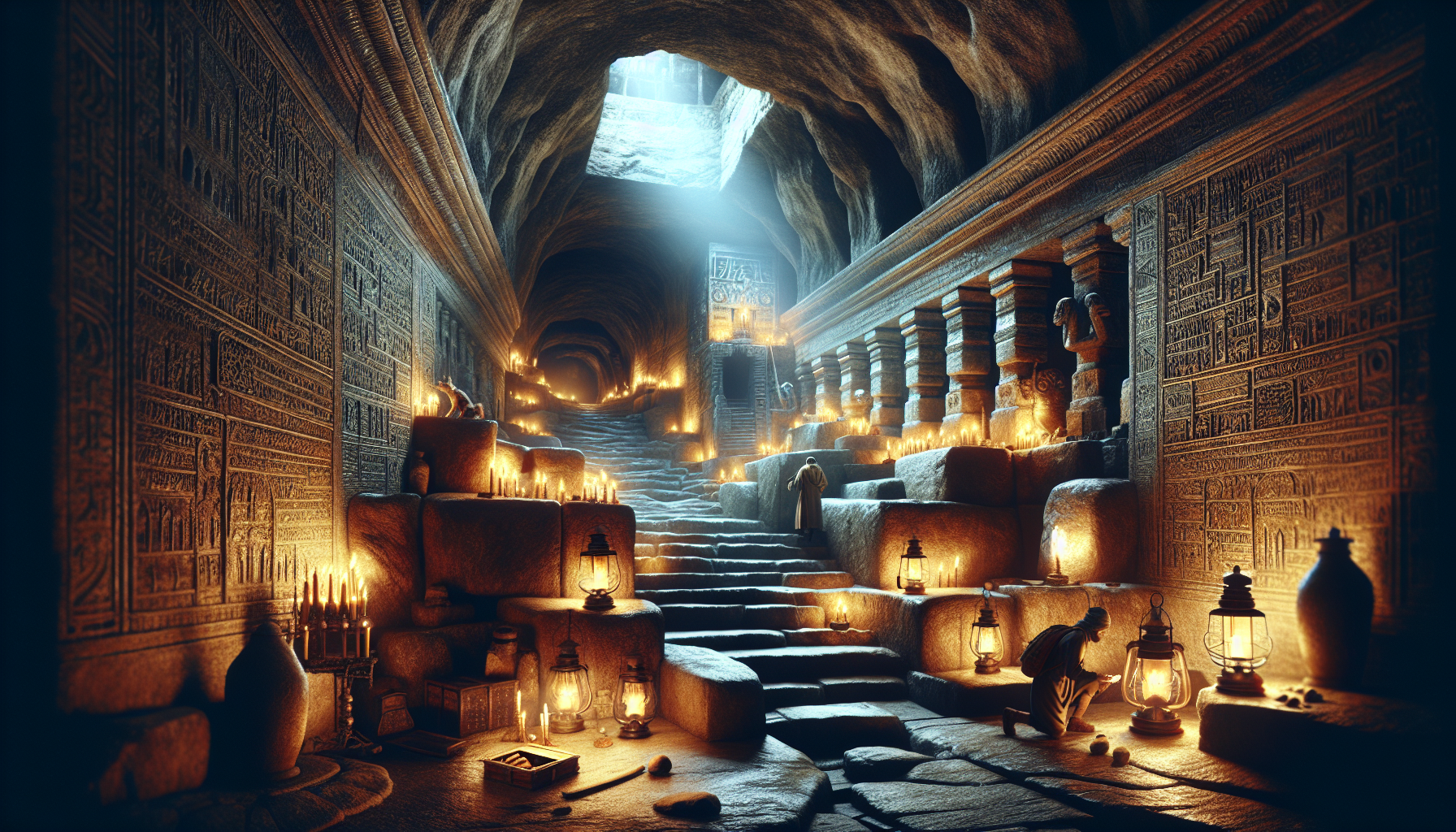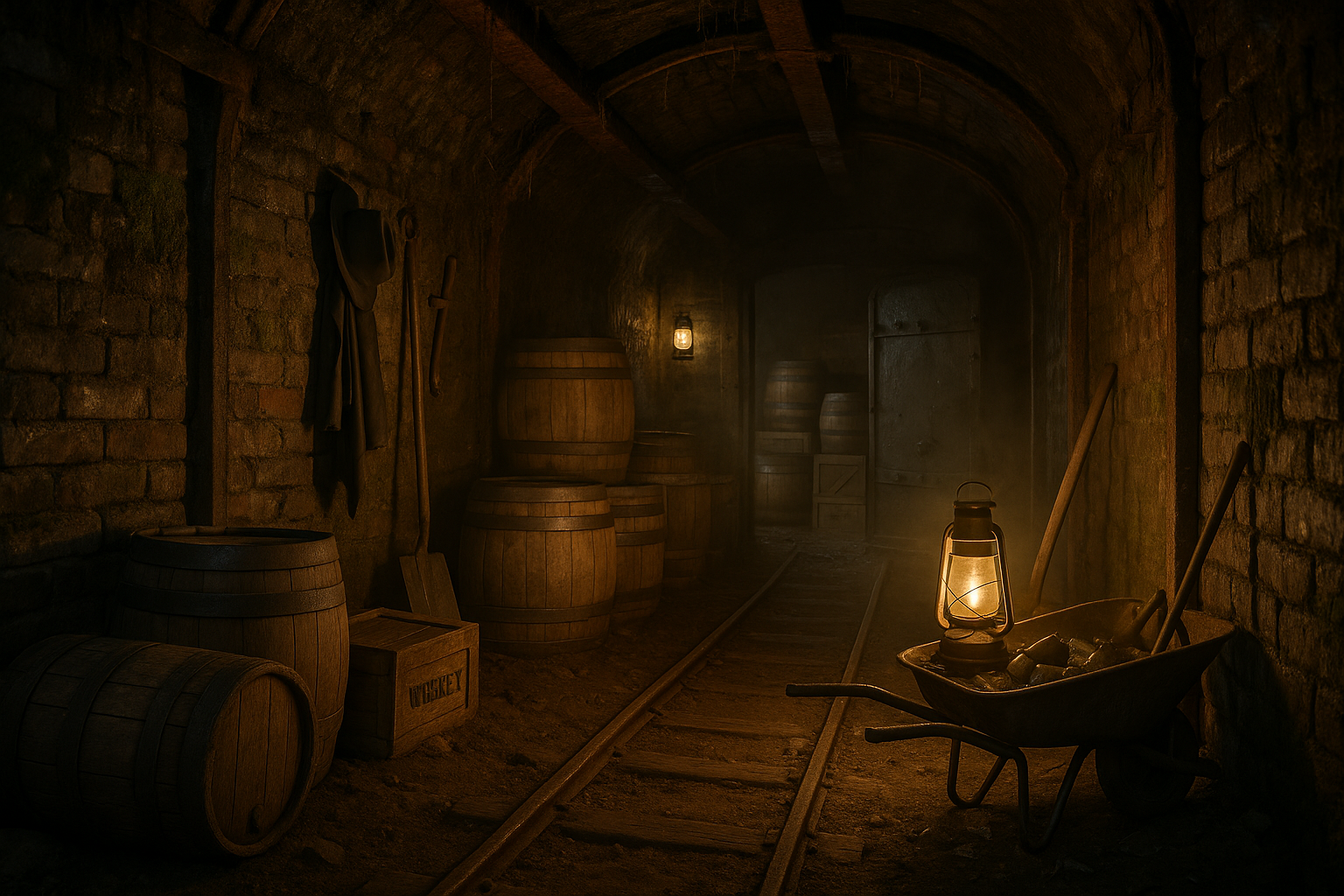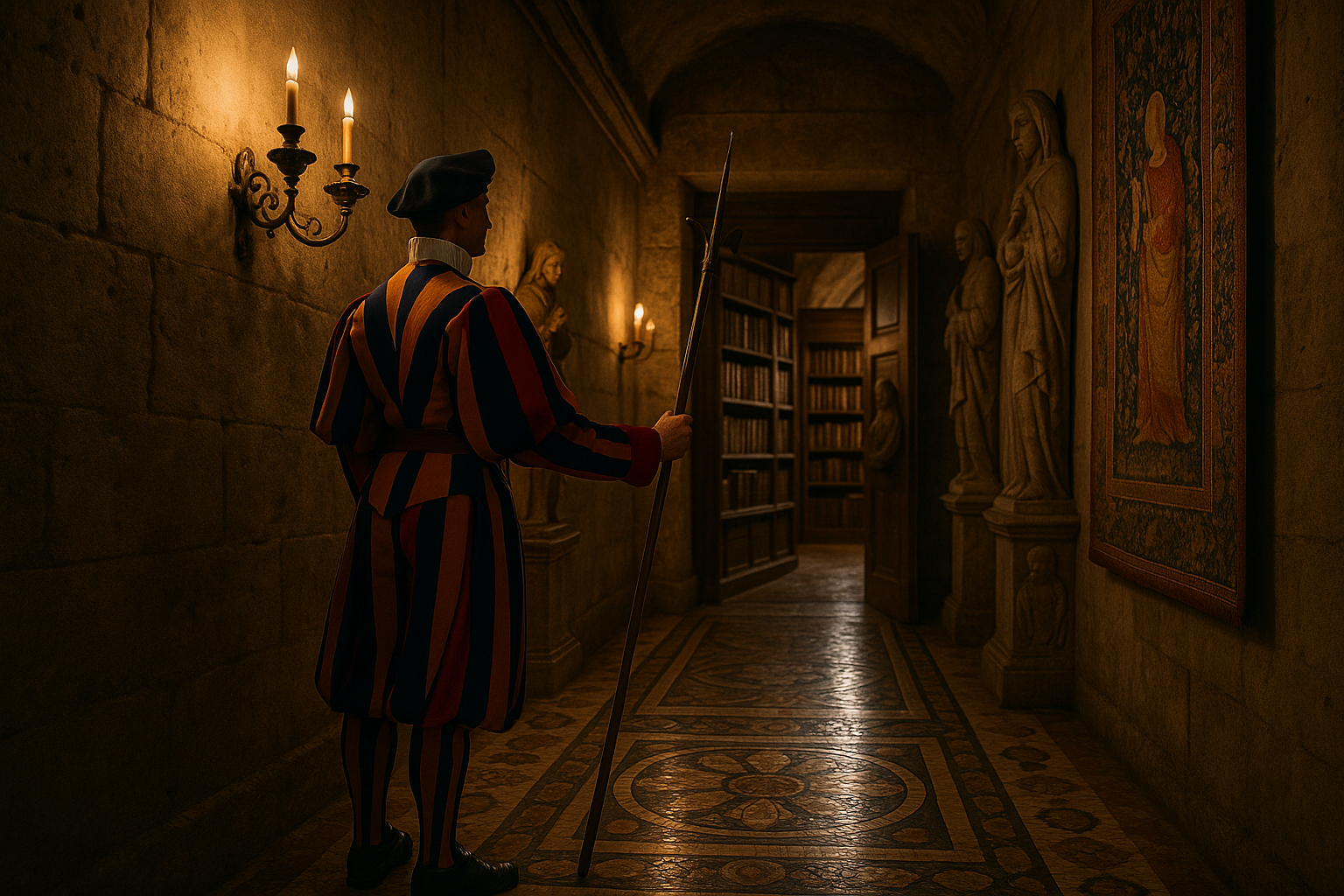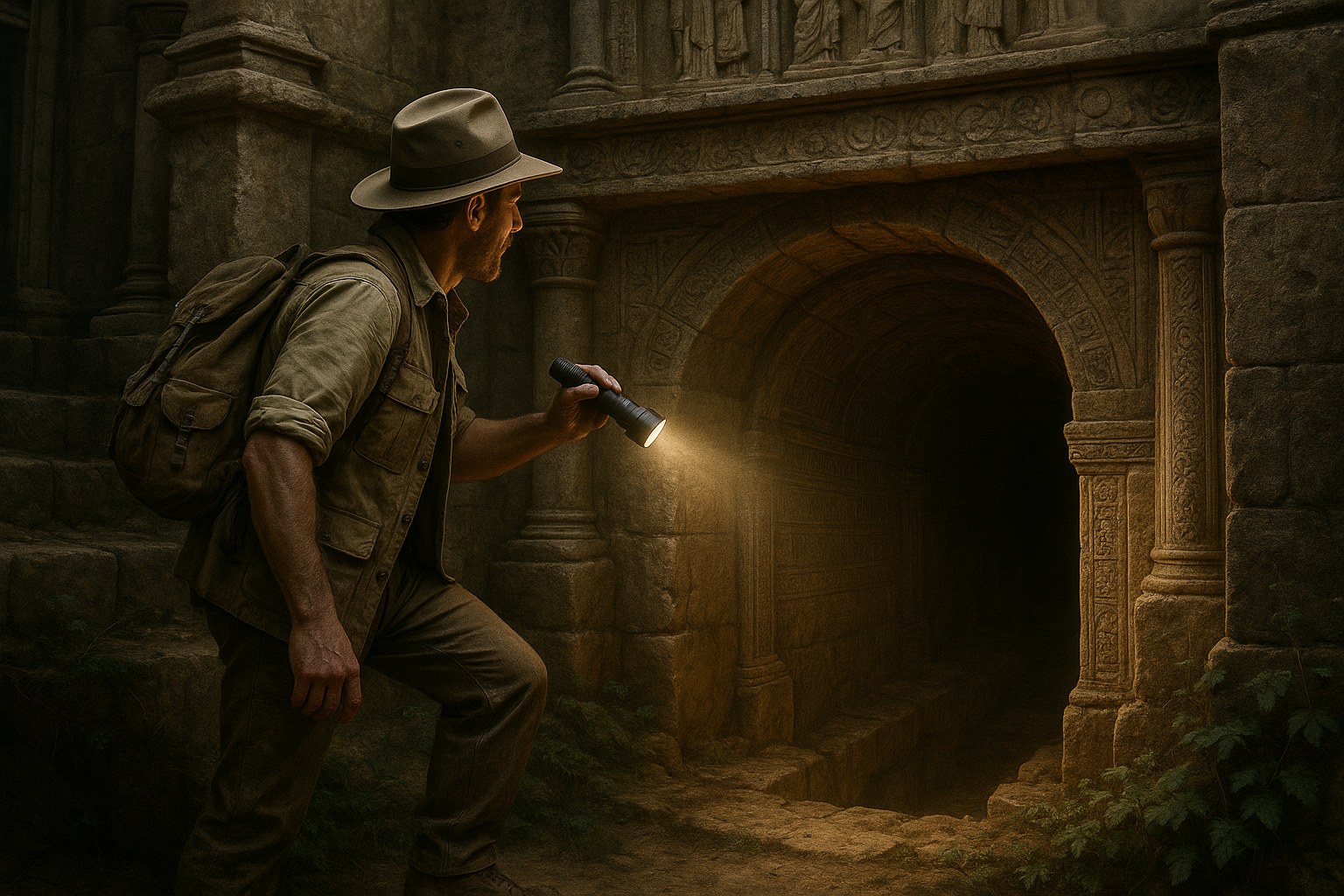Nestled in the heart of Rome, the Vatican City stands as a bastion of religious authority, history, and culture. Millions of visitors flock to this sacred enclave each year, eager to witness the grandeur of St. Peter’s Basilica, the awe-inspiring artistry of the Sistine Chapel, and the serene beauty of the Vatican Gardens. Yet, while much attention is given to these surface treasures, a world of intrigue and enigma lies hidden beneath the cobbled streets and majestic edifices of the Vatican. This article invites you on an exclusive journey below the surface, into the mysterious underground world that holds secrets from the past and whispers of untold stories. 🚶♂️
Beneath the opulence and the hallowed grounds of the Vatican lies a labyrinth of catacombs, crypts, and ancient ruins that are often overshadowed by the more visible wonders above. These subterranean depths are not just mere extensions of the city above but are rich with history and mystique, offering a glimpse into the layers of time that have shaped the Vatican into what it is today. From the earliest Christian burial sites to the tombs of popes, the underground Vatican is a testament to the enduring faith and evolving traditions of the Catholic Church. It’s a place where archaeology and spirituality converge, revealing hidden facets of history and religion that are often left unexplored.
Our journey begins with the Vatican Necropolis, an ancient burial ground that predates St. Peter’s Basilica. This sacred site is believed to be the final resting place of St. Peter himself, the apostle and first pope, whose remains were venerated and protected for centuries. The necropolis offers a fascinating insight into early Christian burial practices, as well as the transition from paganism to Christianity in Rome. As we delve deeper into this silent city of the dead, we encounter intricately decorated tombs and inscriptions that speak of a bygone era, preserving the stories and beliefs of those who came before us.
Continuing our exploration, we find ourselves in the Grottoes of the Vatican, a network of chapels and tombs that lies directly beneath St. Peter’s Basilica. Here, the air is thick with reverence, and the dimly lit corridors echo with the footsteps of pilgrims who have come to pay their respects to the popes interred within. The Grottoes are not just a place of burial but a testament to the continuity of the papacy, where each pope’s legacy is enshrined in stone and memory. As we navigate this hallowed ground, we uncover stories of power, devotion, and the ever-evolving face of the Church throughout the ages.
Finally, our subterranean journey culminates in the discovery of hidden chambers and secret passages that are rarely seen by the public. These concealed spaces offer a tantalizing glimpse into the clandestine operations and mysteries that have intrigued historians and theologians for centuries. From ancient archives to forgotten relics, the Vatican’s underground world is a treasure trove waiting to be explored. Join us as we peel back the layers of time, unlocking the secrets that lie beneath the Holy City, and uncovering the untold stories that continue to shape the legacy of the Vatican. 🌟
The Enigmatic Underworld of the Vatican
The Vatican City, often perceived as a symbol of grandeur and spirituality, harbors a secret world beneath its surface. This underground realm is a labyrinthine network of catacombs, hidden passages, and forgotten chapels, each with its unique story and historical significance. The enigmatic nature of this underworld has intrigued historians, archaeologists, and curious travelers for centuries, all yearning to uncover the mysteries buried beneath the Holy City.
One of the most compelling aspects of the Vatican’s subterranean world is the Necropolis, or “City of the Dead,” which lies directly beneath St. Peter’s Basilica. The Necropolis dates back to the early Christian era, serving as a burial site for pagans and Christians alike. In the mid-20th century, excavations revealed this ancient cemetery, where the alleged tomb of St. Peter was discovered. The significance of this discovery cannot be overstated, as it provides a tangible connection to the apostle, whom many believe was the first pope. The ongoing archaeological work continues to reveal new insights into the lives and beliefs of early Christians.
Below is a comparison of significant discoveries made in the Vatican Necropolis:
| Discovery | Date | Significance |
|---|---|---|
| Tomb of St. Peter | 1940s | Believed to be the resting place of the apostle Peter, the first pope. |
| Christian Mausoleums | 1950s | Early Christian art and inscriptions offer insights into early Christian practices. |
| Pagan Graves | 1960s | Provides context on the coexistence and transition between pagan and Christian traditions. |
For a more visual understanding, watch this fascinating exploration of the Vatican Necropolis: The Vatican Necropolis – Secrets of the Papal Tomb (Vatican News).
Architectural Marvels Below the Vatican
The architectural feats within the Vatican’s underground extend beyond the Necropolis. The subterranean realm is an architectural marvel, featuring ancient Roman structures and Christian crypts interwoven into a cohesive tapestry. Among these wonders is the Vatican Grottoes, a network of chapels and tombs located beneath St. Peter’s Basilica. The Grottoes serve as the final resting place for numerous popes and dignitaries, each tomb meticulously crafted to reflect the occupant’s status and legacy.
The architectural style within the Grottoes varies significantly, with some tombs displaying the grandeur of Renaissance artistry, while others maintain the simplicity of early Christian burials. This juxtaposition highlights the evolution of religious and artistic expression throughout centuries. Moreover, the Grottoes serve as a reminder of the Vatican’s role as a center of power and influence, with each tomb symbolizing the enduring impact of its occupant on the Catholic Church and world history.
Consider the table below for a glimpse into the diversity of the Vatican Grottoes:
| Tomb | Era | Architectural Style |
|---|---|---|
| Pope Gregory XIII | 16th Century | Renaissance |
| Pope Paul VI | 20th Century | Modern |
| Saint Peter’s Tomb | 1st Century | Early Christian |
To further explore the architectural beauty beneath the Vatican, check out this detailed walkthrough: Exploring the Vatican Grottoes (History Channel).
The Spiritual and Historical Significance of the Vatican’s Underground
The Vatican’s underground is not merely a collection of historical artifacts and architectural marvels; it is a place of profound spiritual significance. The catacombs and crypts serve as sacred spaces where pilgrims and visitors alike can reflect on the legacy of the Catholic Church and its influence on the world. The Vatican’s underground also acts as a repository of history, preserving the stories and relics of those who shaped the Church’s trajectory.
Pilgrims visiting the Vatican often experience a deep sense of connection to the past when exploring these subterranean sites. The quietude and solemnity of the underground chapels offer a stark contrast to the bustling life above, providing a space for introspection and prayer. This spiritual journey is further enriched by the historical context provided by each site, allowing visitors to walk in the footsteps of saints and sinners alike.
Furthermore, the Vatican’s underground is a testament to the Church’s resilience and adaptability. Over the centuries, the Church has faced challenges and changes, reflected in the evolution of its underground architecture and art. This adaptability is evident in the seamless integration of pagan and Christian elements, showcasing the Church’s ability to embrace and transform cultural influences throughout history.
To gain a deeper appreciation for the spiritual journey beneath the Vatican, watch this inspiring documentary: A Pilgrim’s Journey Through the Vatican’s Underground (Catholic TV).

Conclusion
As we conclude our journey into the mysterious underground world beneath the Vatican, it is imperative to reflect on the captivating insights we’ve uncovered. The Vatican, renowned for its spiritual significance and architectural grandeur, conceals beneath its surface a labyrinth of history, culture, and spirituality. Our exploration has revealed a complex tapestry of secret passages, ancient necropolises, and enigmatic artifacts that collectively narrate a compelling story of faith, power, and legacy.
Throughout this article, we have delved into several key areas that illuminate the rich tapestry beneath the Holy City. We began by exploring the Vatican Necropolis, an ancient burial ground that offers a glimpse into the early Christian community. This sacred site, located directly beneath St. Peter’s Basilica, is believed to house the tomb of Saint Peter himself. The discovery and excavation of this necropolis have not only provided valuable archaeological insights but have also deepened our understanding of early Christian practices and beliefs.
Another intriguing aspect of our exploration was the examination of the Vatican’s secret archives. These archives, shrouded in mystery and often the subject of speculation, hold a vast collection of documents that span centuries. From papal correspondences to historical treaties, the archives are a treasure trove of information that sheds light on the Vatican’s role in global affairs throughout history. The meticulous preservation of these documents underscores the Vatican’s commitment to maintaining its historical legacy and its influence over time.
The architectural marvels beneath the Vatican, such as the Romanesque and Renaissance structures, also highlight the intricate craftsmanship and artistic vision that have defined this sacred site for centuries. These underground chambers and passageways not only serve as a testament to human ingenuity but also as a reminder of the enduring influence of the Catholic Church. The blend of art and architecture found in these subterranean spaces speaks to the profound impact of religious devotion on human creativity.
As we ventured further, the enigmatic tales and legends associated with the Vatican’s underground world came to light. Stories of secret rituals, hidden treasures, and mystical symbols have fueled imaginations and sparked curiosity for generations. While some of these stories may border on the mythical, they nevertheless contribute to the allure and mystique of the Vatican, inviting scholars and enthusiasts alike to seek the truth behind the legends.
The significance of unveiling these secret depths extends beyond mere curiosity. It offers an opportunity to reflect on the intersection of faith, history, and culture. By understanding the layers of history embedded beneath the Vatican, we gain a deeper appreciation for the complexities and nuances of the Catholic Church’s influence on global history and spirituality. This exploration encourages us to consider how the past shapes our present and informs our future.
In reinforcing the importance of this topic, it is crucial to acknowledge that the Vatican’s underground world is not just a relic of the past; it is a living testament to the enduring legacy of the Catholic Church. As such, it continues to inspire faith and curiosity among millions around the world. The ongoing preservation efforts and scholarly research into these subterranean spaces ensure that future generations can continue to explore and learn from this rich tapestry of history.
As we conclude, I invite you, dear reader, to reflect on the insights gained from this exploration. Consider how the hidden depths of the Vatican might inspire you in your own journey of discovery, whether it be in the realm of history, spirituality, or personal growth. The mysteries of the Vatican’s underground world are an invitation to delve deeper into the stories that shape our world and to uncover the truths that lie beneath the surface.
I encourage you to share this article with others who may be intrigued by the mysteries of the Vatican. Engage in discussions, share your thoughts, and contribute to the ongoing dialogue surrounding this fascinating topic. By doing so, you become a part of a broader community of curious minds, united in the pursuit of knowledge and understanding.
In closing, let us carry forward the inspiration drawn from this exploration. Whether through visiting the Vatican, engaging in scholarly pursuits, or simply reflecting on the lessons of history, let us embrace the spirit of discovery and wonder that the Vatican’s underground world embodies. May this journey ignite a passion for learning and a deeper connection to the rich tapestry of our shared human heritage. 🌍📜
For further reading and exploration, consider these resources:
–
– Vatican Necropolis Tour Information
– The Vatican Secret Archives
Thank you for joining us on this captivating journey beneath the Holy City.
Toni Santos is a visual storyteller and artisan whose work explores the quiet power of what lies beneath. With a deep fascination for subterranean and hidden architecture, Toni uncovers the layers, voids, and forgotten spaces that shape our built environment from the shadows.
His art is a journey through the unseen — from ancient underground chambers to sealed passageways, service tunnels, and foundations buried in time. Each creation tells a story of silence, secrecy, and structure — revealing how absence and concealment can be just as meaningful as what’s visible above ground.
Whether working through visual compositions, architectural studies, or symbolic handcrafted pieces, Toni captures the soul of hidden spaces. His work bridges art and archaeology, blending design with discovery. Trained in visual design and traditional techniques, Toni creates with intention. His pieces don’t just depict — they interpret, inviting viewers to rethink what space, memory, and architecture mean when they’re hidden from view.
As the creative force behind Vizevex, Toni shares this perspective through curated visual narratives, symbolic collections, and interpretive essays that give voice to the quiet geometries beneath our feet.
His work is a tribute to:
The mystery of spaces built to be forgotten
The symbolism embedded in foundations, voids, and passageways
The timeless connection between human intention and hidden structure
Whether you’re an artist, an urban explorer, or someone fascinated by the unseen frameworks that support our world, Toni invites you into a realm where architecture becomes myth — one corridor, one layer, one buried story at a time.





